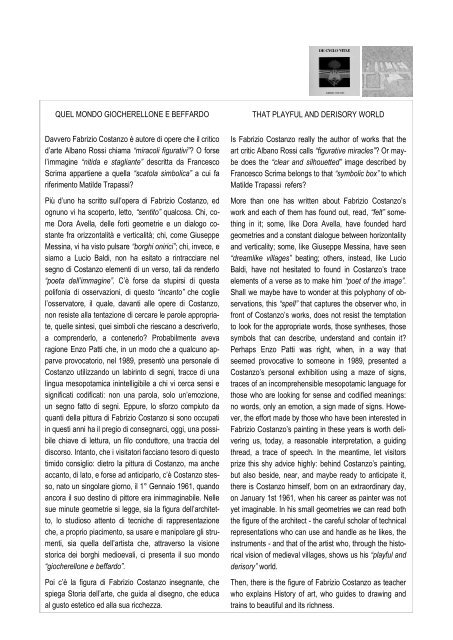You also want an ePaper? Increase the reach of your titles
YUMPU automatically turns print PDFs into web optimized ePapers that Google loves.
QUEL MONDO GIOCHERELLONE E BEFFARDO<br />
THAT PLAYFUL AND DERISORY WORLD<br />
Davvero Fabrizio Costanzo è autore di opere che il critico<br />
d’arte Albano Rossi chiama “miracoli figurativi”? O forse<br />
l’immagine “nitida e stagliante” descritta da Francesco<br />
Scrima appartiene a quella “scatola simbolica” a cui fa<br />
riferimento Matilde Trapassi?<br />
Più d’uno ha scritto sull’opera di Fabrizio Costanzo, ed<br />
ognuno vi ha scoperto, letto, “sentito” qualcosa. Chi, come<br />
Dora Avella, delle forti geometrie e un dialogo costante<br />
fra orizzontalità e verticalità; chi, come Giuseppe<br />
Messina, vi ha visto pulsare “borghi onirici”; chi, invece, e<br />
siamo a Lucio Baldi, non ha esitato a rintracciare nel<br />
segno di Costanzo elementi di un verso, tali da renderlo<br />
“poeta dell’immagine”. C’è forse da stupirsi di questa<br />
polifonia di osservazioni, di questo “incanto” che coglie<br />
l’osservatore, il quale, davanti alle opere di Costanzo,<br />
non resiste alla tentazione di cercare le parole appropriate,<br />
quelle sintesi, quei simboli che riescano a descriverlo,<br />
a comprenderlo, a contenerlo? Probabilmente aveva<br />
ragione Enzo Patti che, in un modo che a qualcuno apparve<br />
provocatorio, nel 1989, presentò una personale di<br />
Costanzo utilizzando un labirinto di segni, tracce di una<br />
lingua mesopotamica inintelligibile a chi vi cerca sensi e<br />
significati codificati: non una parola, solo un’emozione,<br />
un segno fatto di segni. Eppure, lo sforzo compiuto da<br />
quanti della pittura di Fabrizio Costanzo si sono occupati<br />
in questi anni ha il pregio di consegnarci, oggi, una possibile<br />
chiave di lettura, un filo conduttore, una traccia del<br />
discorso. Intanto, che i visitatori facciano tesoro di questo<br />
timido consiglio: dietro la pittura di Costanzo, ma anche<br />
accanto, di lato, e forse ad anticiparlo, c’è Costanzo stesso,<br />
nato un singolare giorno, il 1° Gennaio 1961, quando<br />
ancora il suo destino di pittore era inimmaginabile. Nelle<br />
sue minute geometrie si legge, sia la figura dell’architetto,<br />
lo studioso attento di tecniche di rappresentazione<br />
che, a proprio piacimento, sa usare e manipolare gli strumenti,<br />
sia quella dell’artista che, attraverso la visione<br />
storica dei borghi medioevali, ci presenta il suo mondo<br />
“giocherellone e beffardo”.<br />
Poi c’è la figura di Fabrizio Costanzo insegnante, che<br />
spiega Storia dell’arte, che guida al disegno, che educa<br />
al gusto estetico ed alla sua ricchezza.<br />
Is Fabrizio Costanzo really the author of works that the<br />
art critic Albano Rossi calls “figurative miracles”? Or maybe<br />
does the “clear and silhouetted” image described by<br />
Francesco Scrima belongs to that “symbolic box” to which<br />
Matilde Trapassi refers?<br />
More than one has written about Fabrizio Costanzo’s<br />
work and each of them has found out, read, “felt” something<br />
in it; some, like Dora Avella, have founded hard<br />
geometries and a constant dialogue between horizontality<br />
and verticality; some, like Giuseppe Messina, have seen<br />
“dreamlike villages” beating; others, instead, like Lucio<br />
Baldi, have not hesitated to found in Costanzo’s trace<br />
elements of a verse as to make him “poet of the image”.<br />
Shall we maybe have to wonder at this polyphony of observations,<br />
this “spell” that captures the observer who, in<br />
front of Costanzo’s works, does not resist the temptation<br />
to look for the appropriate words, those syntheses, those<br />
symbols that can describe, understand and contain it?<br />
Perhaps Enzo Patti was right, when, in a way that<br />
seemed provocative to someone in 1989, presented a<br />
Costanzo’s personal exhibition using a maze of signs,<br />
traces of an incomprehensible mesopotamic language for<br />
those who are looking for sense and codified meanings:<br />
no words, only an emotion, a sign made of signs. However,<br />
the effort made by those who have been interested in<br />
Fabrizio Costanzo’s painting in these years is worth delivering<br />
us, today, a reasonable interpretation, a guiding<br />
thread, a trace of speech. In the meantime, let visitors<br />
prize this shy advice highly: behind Costanzo’s painting,<br />
but also beside, near, and maybe ready to anticipate it,<br />
there is Costanzo himself, born on an extraordinary day,<br />
on January 1st 1961, when his career as painter was not<br />
yet imaginable. In his small geometries we can read both<br />
the figure of the architect - the careful scholar of technical<br />
representations who can use and handle as he likes, the<br />
instruments - and that of the artist who, through the historical<br />
vision of medieval villages, shows us his “playful and<br />
derisory” world.<br />
Then, there is the figure of Fabrizio Costanzo as teacher<br />
who explains History of art, who guides to drawing and<br />
trains to beautiful and its richness.


